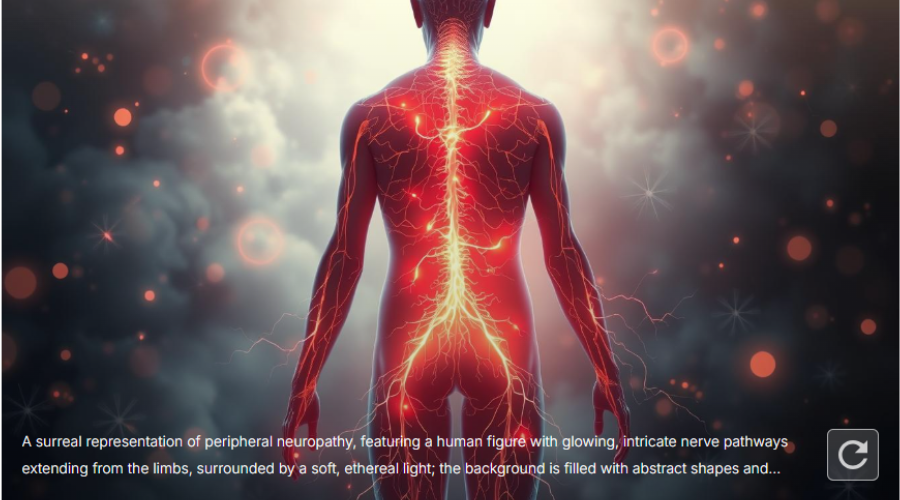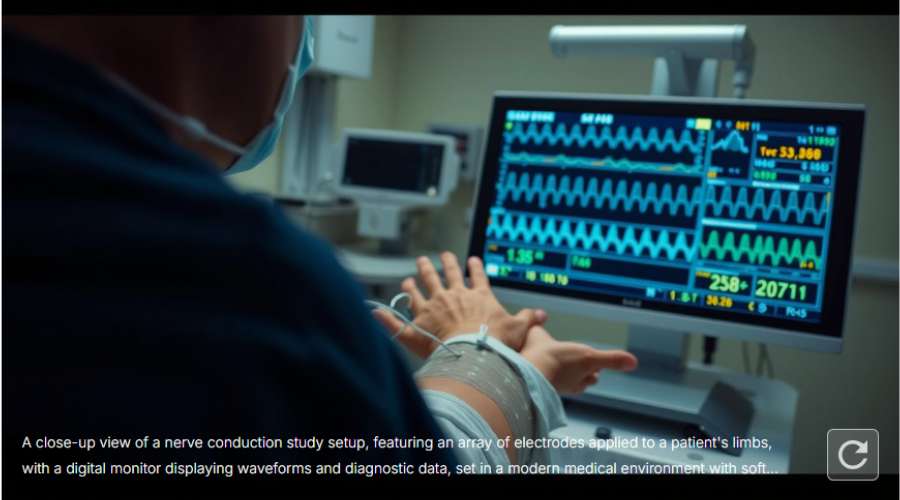Peripheral Neuropathy
Peripheral neuropathy, or neuropatia periférica, affects the nerves outside the brain and spinal cord. It causes numbness, tingling, and pain. This condition can really change a person’s life, so it’s important to know about it.
Products like NervoVive help manage peripheral neuropathy. They support the nervous system. Knowing about peripheral neuropathy and its effects is key to managing it well.

A surreal representation of peripheral neuropathy, featuring a human figure with glowing, intricate nerve pathways extending from the limbs, surrounded by a soft, ethereal light; the background is filled with abstract shapes and colors symbolizing sensations like tingling and numbness, creating a dreamlike atmosphere.
Many things can cause peripheral neuropathy, like diabetes, injuries, and some medicines. These can lead to nerve damage and neuropatia periférica. To manage it, you need to make lifestyle changes, use pain management, and have support.
Key Takeaways
- Peripheral neuropathy is a condition that affects the peripheral nerves, causing numbness, tingling, and pain.
- Neuropatia periférica and dano nervoso are terms used to describe peripheral neuropathy and nerve damage.
- Understanding the causes and symptoms of peripheral neuropathy is crucial for effective management and treatment.
- Products like NervoVive can help manage peripheral neuropathy by supporting the health of the nervous system.
- Lifestyle modifications and pain management techniques are essential for managing peripheral neuropathy.
- Early diagnosis and treatment can significantly improve the quality of life for individuals with peripheral neuropathy.
Understanding Peripheral Neuropathy
The peripheral nervous system is key in sending signals from the brain to the body. To get peripheral neuropathy, we need to know how this system works and the nerve damage types. This condition can cause sensação de formigamento, or a tingling feeling, and dor no nervo, or nerve pain.
Neuropatia diabética, or diabetic neuropathy, is a common cause. It happens when high blood sugar damages nerves. There are different nerve damage types, including:
- Autonomic nerve damage, which affects the autonomic nervous system
- Motor nerve damage, leading to muscle weakness and wasting
- Sensory nerve damage, causing numbness, tingling, and pain
Knowing the nerve damage types is key for effective treatments. By understanding symptoms and causes, people can manage their condition and prevent more damage.
Common Causes and Risk Factors
Peripheral neuropathy can come from many sources. This includes medical conditions, injuries, and lifestyle choices. For example, diabetes can raise the risk of dor neuropática, a nerve pain type. Also, distúrbio nervoso can lead to peripheral neuropathy.
Some common causes of peripheral neuropathy include:
- Diabetes
- Injuries, such as trauma or surgery
- Infections, such as Lyme disease or shingles
- Autoimmune disorders, such as rheumatoid arthritis or lupus
- Lifestyle factors, such as smoking or excessive alcohol consumption
Knowing the causes and risk factors of peripheral neuropathy helps. It lets people take steps to lower their risk. By managing health conditions and making healthy choices, they can reduce the risk of dor neuropática and distúrbio nervoso.https://www.youtube.com/embed/tsLceCXAeU0
It’s key to know the causes and risk factors of peripheral neuropathy. This way, people can take steps to prevent it. If symptoms show up, they should seek medical help. Being informed and proactive can help manage the condition if it happens.
Recognizing the Signs and Symptoms of Peripheral Neuropathy
Peripheral neuropathy shows itself in many ways. It’s key to know the signs and symptoms to get the right treatment. The symptoms depend on the nerve damage type and where it is. Knowing the common symptoms, like sintomas de danos nos nervos, helps in diagnosing and treating tratamento de danos nos nervos.
The symptoms fall into three main categories: sensory, motor, and autonomic.
Sensory Symptoms
Sensory symptoms happen when sensory nerves get damaged. These nerves send signals for touch, pain, and temperature. Common symptoms include numbness, tingling, and pain in certain areas.
Motor Symptoms
Motor symptoms occur when motor nerves get damaged. These nerves control muscle movement. Symptoms include muscle weakness, twitching, and cramps.
Autonomic Symptoms
Autonomic symptoms happen when autonomic nerves get damaged. These nerves control things like heart rate, blood pressure, and digestion. Symptoms include dizziness, nausea, and changes in bowel or bladder function.
Spotting the signs and symptoms of peripheral neuropathy is the first step. It leads to getting the right treatment and managing the condition well. By knowing the common symptoms and getting medical help, people can get the right tratamento de danos nos nervos. This improves their life quality.
Diagnostic Process and Testing Methods
To diagnose neuropatia periférica, a thorough approach is needed. This includes a physical exam, looking at medical history, and running special tests. These steps help find the cause of nerve damage and how much damage there is.
The first step is a physical exam. A doctor checks the patient’s health and how their nerves work. This is key to spotting signs like numbness, tingling, or weakness in muscles.
Specialized Tests
There are several tests to diagnose neuropatia periférica:
- Nerve conduction studies: These tests check how fast and strong electrical signals travel in nerves.
- Laboratory tests: These look for conditions like diabetes or vitamin shortages that might harm nerves.
- Imaging studies: MRI or CT scans can spot structural issues that might be hurting nerves.
Doctors use these test results to create a treatment plan. This plan aims to manage neuropatia periférica and ease symptoms of nerve damage.

A close-up view of a nerve conduction study setup, featuring an array of electrodes applied to a patient’s limbs, with a digital monitor displaying waveforms and diagnostic data, set in a modern medical environment with soft lighting and sterile equipment.
Getting a diagnosis early and starting treatment quickly is crucial. It helps prevent more nerve damage and improves life quality for those with neuropatia periférica.
Treatment Approaches for Peripheral Neuropathy
Peripheral neuropathy treatment varies based on the cause and symptom severity. Effective tratamento de danos nos nervos combines lifestyle changes, pain management, and support. Products like NervoVive support the nervous system, helping with neuropathy.
Common treatments for peripheral neuropathy include:
- Lifestyle changes like exercise and a balanced diet
- Pain management with medication and therapy
- Support from counseling and groups
Managing dor neuropática is key in treating peripheral neuropathy. This involves medication, therapy, and lifestyle changes. By tackling the root cause and symptoms, people can live better and avoid more problems.
It’s vital to work with a healthcare professional for a tailored treatment plan. The right approach helps manage peripheral neuropathy, improving health and well-being.
| Treatment Approach | Description |
|---|---|
| Lifestyle Modifications | Regular exercise, balanced diet, and stress management |
| Pain Management | Medication, therapy, and alternative treatments |
| Support Systems | Counseling, support groups, and education |
Managing Daily Life with Nerve Damage
Living with peripheral neuropathy means making big changes in your life. Start by exercising often and eating well. A diet full of fruits, veggies, and whole grains helps keep blood sugar in check and stops nerve damage.
Adding stress-reducing activities like yoga or meditation can help. These practices can lessen pain and boost your mood. Also, sleep well and cut down on alcohol to fight neuropathy symptoms.
Lifestyle Modifications
- Exercise regularly to improve blood flow and reduce pain
- Eat a healthy, balanced diet to regulate blood sugar levels
- Get enough sleep to help the body repair damaged nerves

A serene kitchen scene with a variety of healthy foods, such as whole grains, fresh vegetables, and fruits, alongside a cozy seating area that includes a soft chair and footrest. Light filtering through a window, showcasing tools for self-care like massage balls and a heating pad, all creating a calming atmosphere for managing diabetic neuropathy.
Pain Management Techniques
There are many ways to manage pain from peripheral neuropathy. Try physical therapy, medication, or acupuncture. Always talk to a doctor to find the best plan for you.
Support Systems and Resources
Having a strong support system is key. Look for support groups, counseling, and learn about neuropatia diabética and distúrbio nervoso. By being proactive, you can live better and feel less pain.
Prevention Strategies and Risk Reduction
To prevent peripheral neuropathy, we need to take action. This includes making lifestyle changes and reducing risks. Smoking and drinking too much alcohol can raise your risk. This can lead to sensação de formigamento and dor no nervo.
Keeping a healthy lifestyle is key. Here’s how:
- Eat foods like fruits, veggies, and whole grains.
- Exercise often to boost blood flow and health.
- Manage stress with meditation or yoga.
- Stay away from harmful substances and some medicines.
By following these tips, you can lower your risk of peripheral neuropathy. This helps avoid sensação de formigamento and dor no nervo. Being proactive is important for your health.
Conclusion: Living Well with Peripheral Neuropathy
Living well with peripheral neuropathy means using a few key steps. First, get a proper diagnosis and effective treatment. Then, make smart lifestyle changes. Knowing the symptoms of nerve damage and getting help early can really help.
Working with doctors, you can create a treatment plan that works for you. This plan can help fix the neuropatia periférica and reduce dano nervoso. With the right mix of medicine, therapy, and lifestyle changes, many people can overcome this condition.
Adopting a holistic approach is key. Focus on self-care, managing pain, and using support systems. This way, people with sintomas de danos nos nervos can adapt and thrive. With the right support and care, you can live a fulfilling life despite peripheral neuropathy.
FAQ
What is peripheral neuropathy?
Peripheral neuropathy is a condition that affects the peripheral nerves. It causes numbness, tingling, and pain.
What causes peripheral neuropathy?
It can be caused by diabetes, injury, and infection.
What are the common symptoms of peripheral neuropathy?
Symptoms vary based on the nerve damage and location. They include sensory, motor, and autonomic symptoms.
How is peripheral neuropathy diagnosed?
Diagnosing it involves a physical exam, medical history, and tests. These include nerve conduction studies and imaging.
What are the treatment options for peripheral neuropathy?
Treatment depends on the cause and symptom severity. It includes lifestyle changes, pain management, and support. Products like NervoVive may also be used.
How can I manage daily life with nerve damage?
Managing daily life requires a comprehensive approach. This includes lifestyle changes, pain management, and support systems.
How can I prevent peripheral neuropathy?
Preventing it requires a proactive approach. This includes lifestyle changes and risk reduction strategies.



